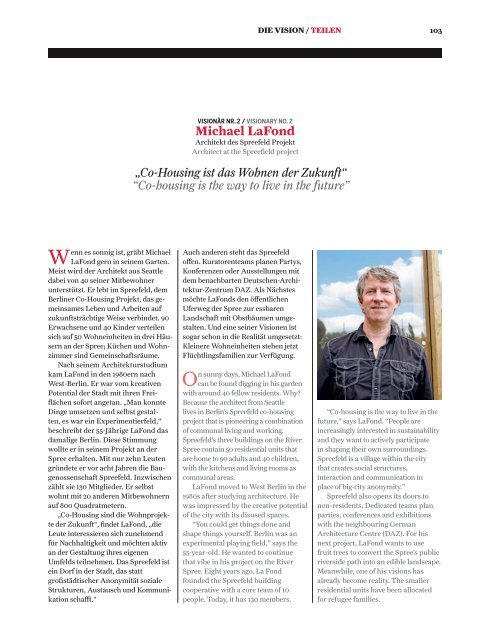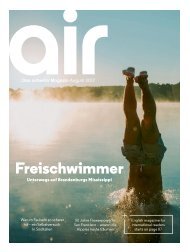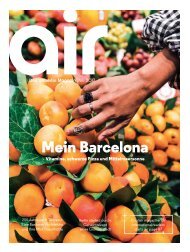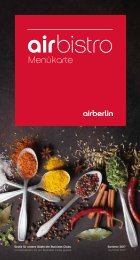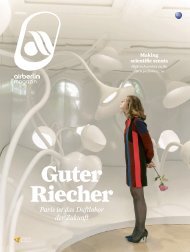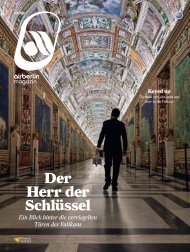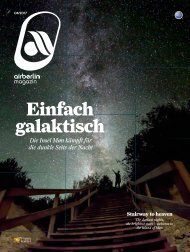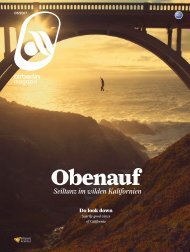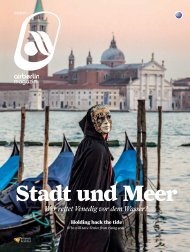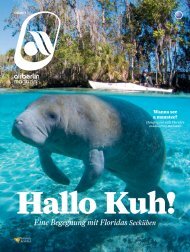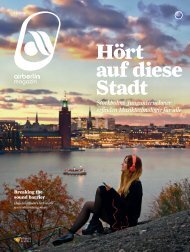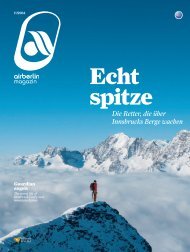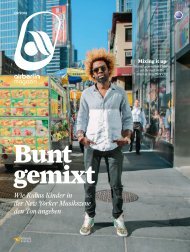Sie wollen auch ein ePaper? Erhöhen Sie die Reichweite Ihrer Titel.
YUMPU macht aus Druck-PDFs automatisch weboptimierte ePaper, die Google liebt.
DIE VISION / TEILEN<br />
103<br />
VISIONÄR NR. 2 / VISIONARY NO. 2<br />
Michael LaFond<br />
Architekt des Spreefeld Projekt<br />
Architect at the Spreefield project<br />
„Co-Housing ist das Wohnen der Zukunft“<br />
“Co-housing is the way to live in the future”<br />
Wenn es sonnig ist, gräbt Michael<br />
LaFond gern in seinem Garten.<br />
Meist wird der Architekt aus Seattle<br />
dabei von 40 seiner Mitbewohner<br />
unterstützt. Er lebt im Spreefeld, dem<br />
Berliner Co-Housing Projekt, das gemeinsames<br />
Leben und Arbeiten auf<br />
zukunftsträchtige Weise verbindet. 90<br />
Erwachsene und 40 Kinder verteilen<br />
sich auf 50 Wohneinheiten in drei Häusern<br />
an der Spree; Küchen und Wohnzimmer<br />
sind Gemeinschaftsräume.<br />
Nach seinem Architekturstudium<br />
kam LaFond in den 1980ern nach<br />
West-Berlin. Er war vom kreativen<br />
Potential der Stadt mit ihren Freiflächen<br />
sofort angetan. „Man konnte<br />
Dinge umsetzen und selbst gestalten,<br />
es war ein Experimentierfeld,“<br />
beschreibt der 55-Jährige LaFond das<br />
damalige Berlin. Diese Stimmung<br />
wollte er in seinem Projekt an der<br />
Spree erhalten. Mit nur zehn Leuten<br />
gründete er vor acht Jahren die Baugenossenschaft<br />
Spreefeld. Inzwischen<br />
zählt sie 130 Mitglieder. Er selbst<br />
wohnt mit 20 anderen Mitbewohnern<br />
auf 800 Quadratmetern.<br />
„Co-Housing sind die Wohnprojekte<br />
der Zukunft“, findet LaFond, „die<br />
Leute interessieren sich zunehmend<br />
für Nachhaltigkeit und möchten aktiv<br />
an der Gestaltung ihres eigenen<br />
Umfelds teilnehmen. Das Spreefeld ist<br />
ein Dorf in der Stadt, das statt<br />
großstädtischer Anonymität soziale<br />
Strukturen, Austausch und Kommunikation<br />
schafft.“<br />
Auch anderen steht das Spreefeld<br />
offen. Kuratorenteams planen Partys,<br />
Konferenzen oder Ausstellungen mit<br />
dem benachbarten Deutschen-Architektur-Zentrum<br />
DAZ. Als Nächstes<br />
möchte LaFonds den öffentlichen<br />
Uferweg der Spree zur essbaren<br />
Landschaft mit Obstbäumen umgestalten.<br />
Und eine seiner Visionen ist<br />
sogar schon in die Realität umgesetzt:<br />
Kleinere Wohneinheiten stehen jetzt<br />
Flüchtlingsfamilien zur Verfügung.<br />
On sunny days, Michael LaFond<br />
can be found digging in his garden<br />
with around 40 fellow residents. Why?<br />
Because the architect from Seattle<br />
lives in Berlin’s Spreefeld co-housing<br />
project that is pioneering a combination<br />
of communal living and working.<br />
Spreefeld’s three buildings on the River<br />
Spree contain 50 residential units that<br />
are home to 90 adults and 40 children,<br />
with the kitchens and living rooms as<br />
communal areas.<br />
LaFond moved to West Berlin in the<br />
1980s after studying architecture. He<br />
was impressed by the creative potential<br />
of the city with its disused spaces.<br />
“You could get things done and<br />
shape things yourself. Berlin was an<br />
experimental playing field,” says the<br />
55-year-old. He wanted to continue<br />
that vibe in his project on the River<br />
Spree. Eight years ago, La Fond<br />
founded the Spreefeld building<br />
cooperative with a core team of 10<br />
people. Today, it has 130 members.<br />
“Co-housing is the way to live in the<br />
future,” says LaFond. “People are<br />
increasingly interested in sustainability<br />
and they want to actively participate<br />
in shaping their own surroundings.<br />
Spreefeld is a village within the city<br />
that creates social structures,<br />
interaction and communication in<br />
place of big-city anonymity.”<br />
Spreefeld also opens its doors to<br />
non-residents. Dedicated teams plan<br />
parties, conferences and exhibitions<br />
with the neighbouring German<br />
Architecture Centre (DAZ). For his<br />
next project, LaFond wants to use<br />
fruit trees to convert the Spree’s public<br />
riverside path into an edible landscape.<br />
Meanwhile, one of his visions has<br />
already become reality. The smaller<br />
residential units have been allocated<br />
for refugee families.


